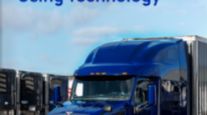iTECH: Cracking Down on Fuel Card Fraud
By Dan Calabrese, Contributing Writer
This article appears in the June/July 2011 issue of iTECH, published in the June 13 print edition of Transport Topics. Click here to subscribe today.
Drivers who carry corporate fuel cards have at their fingertips the opportunity to cheat carriers for personal profit, a reality John Ennis Jr., understands all too well.
Last year, Ennis, the vice president of JNJ Express, Memphis, Tenn., busted some of his drivers reselling fuel charged to the company. The drivers would dispense fuel into their own trucks, then wave forward other drivers — usually friends, family or owner-operators they knew— who paid cash to the JNJ drivers for fill-ups charged to the fleet’s account. The drivers were selling about 50 gallons at a time, large enough to make the scam worthwhile, but small enough not to raise suspicion — at least for a little while.
Ennis said JNJ began to notice some inconsistencies across its 300-truck fleet, and started interviewing drivers. Eventually, one of them cracked and disclosed the scheme.
No fleet wants to believe its drivers would perpetrate such a scam, but technologies under development and others available now can curtail these shady dealings through systems that require the truck and pump to link up electronically before the first gallon is dispensed, and through careful tracking of driver expenses.
These programs give fleets precise and instant information about the operation of their on-the-road assets and alert them when something isn’t adding up.
As Ennis’ experiences suggest, carriers that fail to monitor fuel costs carefully can unknowingly spend thousands of dollars for gallons of diesel pumped into someone else’s tanks.
Statistics on just how much money is lost annually to fraudulent fuel sales are elusive — neither the U.S. Department of Energy nor its Energy Information Administration maintains such records — but the industry is aware that it’s going on.
“We see a couple of high-profile cases almost every year, and there may be others that fleets handle internally,” said Susan Chandler, executive director of the Supply Chain Security and Safety Management Councils of American Trucking Associations. “But with fuel being a fleet’s second-largest expense, it doesn’t happen but once or twice before the carrier takes action.”
That was true for JNJ, but even Ennis warned that thwarting one effort won’t necessarily prevent another. “They’re not going to steal large quantities,” he said. “I probably have drivers stealing my fuel right now.”
And even small amounts can add up, said Ted Jones, president of Transportation Clearing House, a payment processing company in Ogden, Utah.
“A normal truck will pull 1,500 to 1,600 gallons a month,” he said. “If you lose 1% of that, that’s 15 gallons on average per truck. So if you take it at four bucks a gallon, that’s $60 per truck per month. You take a 100-truck company, that’s $6,000 a month.”
TCH is one of several technology companies working with truck-stop chain Pilot Flying J, Knoxville, Tenn., on a system that aims to clamp down on fraudulent transactions via sensors on trucks and fuel pumps that link fuel sales to specific accounts and vehicles. Data collected can red-flag situations in which a truck’s fuel level appears inconsistent with its history of fill-ups.
Pilot Flying J confirmed its involvement in the project and said the technology would be available at all of its locations, but the company left its technology partners to fill in the details.
TCH engaged Zonar Systems Inc., Seattle, to develop a product known as Z-Con, which will be installed on all Pilot Flying J pumps. Z-Con must recognize a device in a vehicle’s windshield, similar to an E-ZPass transponder, before authorizing the driver to fuel up.
Chris Oliver, vice president of marketing for Zonar Systems, said the Z-Con system will allow the vehicle to recognize the pump up ahead and send its vehicle identification number through the TCH network, which then validates the VIN.
The system uses a telematics box on the truck that maintains and updates GPS data, speed information, idling data, odometer readings and fuel-consumption figures.
As Oliver describes it, a flashing light is the device’s way of telling the driver, “Hey, I’m talking to something,” and when the light turns to solid green, the driver knows he’s been authorized to pump fuel. “Essentially, the truck becomes the fuel card,” Oliver said.
A system from QuikQ LLC, Franklin, Tenn., works in much the same way and is being developed to work on fueling sites with three truck-stop operators, said Ernie Betancourt, the company’s president. Like Z-Con, QuikQ’s Fuel Island Manager uses radio-frequency identification tags to link trucks and fuel pumps before authorizing a fill-up.
“Drivers are purchasing agents,” he said. “If you’re going to have that driver be your purchasing agent, with theft and all the other things that go on in our industry, what the carrier wants is to control the fuel transaction.” Betancourt is having “serious conversations” with two truck stops about the system and is optimistic about the third. “We think it will happen,” he said.
TCH’s Jones said the value in these systems resides in the inability to pull someone else’s truck up to a pump.
“You can’t prevent someone siphoning gas out of a tank,” Jones said, “but [it’s] a whole lot more of a problem to siphon
gas out of a tank and sell it in 5-gallon increments than to have a guy pull up to a fuel canopy.”
Richard Sharpe, national fleet director for Canada Cartage System Ltd., Mississauga, Ontario, said he sees potential value in the cardless fuel-purchasing technology.
“If a driver is moving from truck to truck, slip-seating, and carrying the fuel card with them, it can be an arduous endeavor to sort out what fuel went where,” he said. “I certainly see an advantage in all fuel purchases being assessed to the appropriate unit.”
Those systems are designed to prevent fraud at the point of purchase, but tracking software for office use allows managers to parse driver spending and identify potentially fraudulent activity.
“We can calculate when the tank was topped off, and we can determine, based on travel distance between fueling, whether there’s an excess fueling event,” said Thomas Fansler, president of the Vusion division of PeopleNet Communications Corp., Minnetonka, Minn. The Vusion software program tracks distance, travel and implied tank levels, among other data, and reports them back to fleet operators.
When a vehicle needs fill-ups more frequently than its fuel-purchase levels would suggest, the system red-flags the incident and prompts the fleet to investigate.
“We build performance models, and we use those performance models in a couple of ways,” Fansler said. “We use it to validate the data we’re seeing out of the engine, to make sure we’ve got good, actionable engine data. And we also use the physical [fuel] burn rates for those trucks, so we have a way of taking what’s coming off the engine and calibrating that to what the real physical burn on a truck is.” That information, Fansler said, should empower fleet operators to recognize when potential fraud may have occurred.
However, Ennis noted that variations in different routes can make that tracking an arduous task.
“We’ve got trucks not running the same routes, or running over different terrains, so our fuel mileage is going to vary,” he said. “The only thing we can do, if we see some significant variance, is bring the drivers in.” He added that his fleet requires all drivers to put their actual mileage in at the time of fueling.
Fansler said that the Vusion system relies somewhat on human interpretation, but in most cases, the data are easy to decipher.
“It’s not rocket science,” Fansler said. “We know the tank had to be topped off based on the miles and the algorithm. So once we know the tank is full, and we’re tracking miles . . . we know how much the tank is being drawn down between fueling events. We’ll project at what point the vehicle has violated the fuel level.”
Users can set the margins that trigger an alert — for example, if a vehicle’s fuel level is 10 gallons off from what the algorithm says it should be, Fansler said.
The point-of-purchase systems and software programs share one common trait: They rely on people to interpret the data. Conversely, it’s people who will try to circumvent them.
With the point-of-purchase systems, for example, drivers looking to make a quick buck still may find a way, said Glen Sokolis, president of the Sokolis Group, Warrenton, Pa., a fuel management and consulting firm to fleets.
“A truck obviously has two fuel tanks,” he said. “When the guy goes to fuel the other side of the truck, what’s to say he doesn’t slip in another 15 or 20 gallons of fuel into the other guy’s truck anyway?” Fleets, he said, must dedicate time and staffing to review each truck’s performance.
“That’s where the problem lies,” he said. “That truck didn’t really get 6.2 miles to the gallon — it really got 4.5 miles — because of out of 100 gallons the guy bought, 80 gallons went into the tank and the other 20 went into someone else’s tank. [Some] companies lack the sophistication, or don’t have the internal staffing to go back and look at the fuel transaction.”
QuikQ’s Betancourt agreed that the technology is only as good
as the fleet’s capacity to make effective use of it.
“What happens at the fuel island is important, and it’s got the most sizzle,” Betancourt said, “but the back office of the carrier is the key to managing fuel transactions.”
That may be, but some believe the technology could benefit from further advancement.
“At some point in the future, I believe we will use RFID tags where the truck talks directly to the dispenser, instead of fuel cards,” said Steven Graham, vice president of purchasing for Schneider National Inc., Green Bay, Wis. “But the better solution would be something that enables the dispenser to know it has to go directly into the truck it is intended to go into — i.e., the dispenser must interlink with the fill port in the tank. If it doesn’t, it won’t let the dispenser pump.”
Schneider ranks No. 9 on the Transport Topics Top 100 list of the largest U.S. and Canadian for-hire carriers.
Sharpe, meanwhile, said he would like to see detailed tracking beyond fueling stations. “Thinking a little bigger, if equipped with an RFID device and appropriate reading devices at the terminals, instantaneous yard checks could be performed automatically,” he said. “Yard departure and entry times could be accurately tracked and generate push reports.”
Technology is only part of the hesitation expressed by carriers that work with Sokolis.
“People won’t be sure of its acceptance until they’ve seen it work for a while,” he said. “It’s like anything new that comes into the marketplace; until they see that it actually works, people will be very skeptical, especially in the trucking industry.”
Carriers must be equally careful in who they hire to drive their trucks, said Richard Martin, corporate director of security for Knight Transportation Inc., Phoenix. Knight ranks No. 34 on the Transport Topics Top 100 list of the largest U.S. and Canadian for-hire carriers.
“Whether you’re a large fleet with state of the art tracking systems, or a small fleet, you have to know who is hauling your freight and how much fuel they will require to make the run,” Martin said. “Make it clear to the driver what your fuel utilization expectations are in advance. Have a process in place to validate the utilization and procedures to control such utilization if necessary.”




